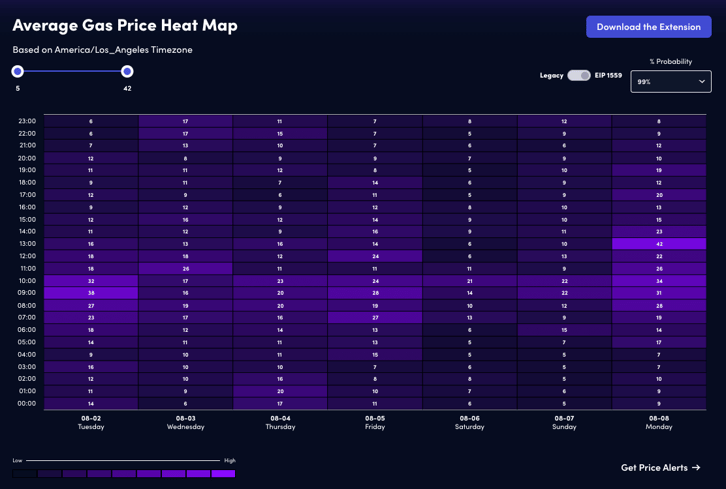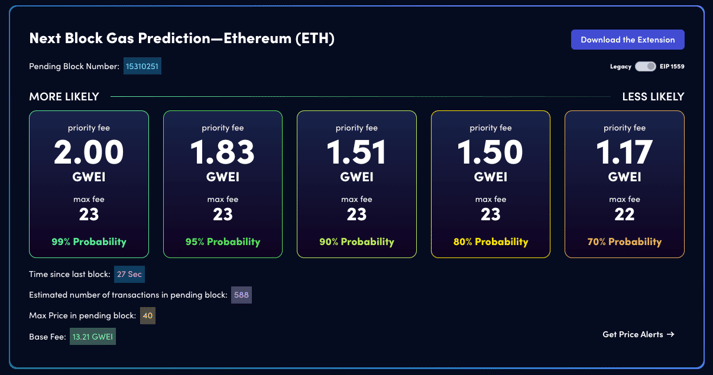Ethereum's high gas fees can often keep builders, traders, and users from completing the transactions that are important to them. It's no secret that during times of extreme mempool congestion, many users are pushed to the sidelines because they’re wary of paying too much for transactions.
Nonetheless, Ethereum remains Web3’s top smart contract platform. While some other blockchains boast lower transaction fees, Ethereum’s rich programming capabilities, mature developer ecosystem, and massive crypto user base keep gaining momentum despite frequently high gas fees.
In this article, we'll cover the basics of ETH gas fees, the economics of high fees, how to avoid them, and what the network is doing to mitigate high gas fees in the future.
What Are ETH Gas Fees?
Gas is required of all users to carry out any function on the Ethereum network. This fee is necessary to prevent spamming of the network. Because there is limited space in each Ethereum block, the gas fee market is often used to prioritize which transactions will be included in the next block.
Each transaction needs a certain amount of computational resources to complete, which requires a gas fee.
A smaller denomination of ether, called "gwei," denotes gas prices, with one gwei equal to 0.000000001 ETH (10-9 ETH). Using gwei as a unit of measure is more convenient because you can just say "one gwei" instead of 0.000000001 ether when talking about gas fees.
The amount of gas a transaction will require depends on the complexity of the transaction. How much a unit of gas will cost depends on the current state of the network. Fees will be highest when there is elevated competition to get into the next block, which congests the network.
Calculating the Cost of Gas
The EIP-1559 gas fee upgrade implemented in August 2021 brought in significant changes to the way gas fees are calculated on the network. This upgrade was done to make transactions more predictable and easier to estimate.
Each block has a "base fee," which is the minimum price of gas for a specific block. This is calculated algorithmically by the network itself assessing the demand for block space. Users are also expected to set a "tip" value, essentially a priority fee per transaction.
This tip serves as compensation for miners carrying out transactions within the blocks.
Gas fees are calculated using the following formula:
Gas units (limit) * (Base fee + Tip)
Note, however, that while this is the standard formula used, the gas limit is not always reached and it is typically auto-set by wallets based on how complex they predict the transaction to be. Adjusting this gas limit manually can often result in a failed tx.
There will usually be a difference between predicted gas vs the gas you really pay. With this in mind, a more accurate formula would be "Units of gas actually used" * (Base fee + Tip). These are the basics, but for a complete overview, we recommend our 101 guide to ETH gas.
Why Are ETH Gas Fees So High?
If you’re experiencing transaction anxiety due to high gas fees, there are a couple of factors that could be at play, including:
- A surge in activity on the network
- You could be executing a complicated transaction
- There is a sustained period of interest in the network
A Surge in Activity on the Network
If there is a flood of users trying to carry out transactions all at once, the gas fee market will skyrocket. These spikes usually occur around popular DeFi or NFT events.
An example of this would be when Bored Ape Yacht Club creators Yuga Labs executed their famous Otherside launch. The launch represented the first time that Otherdeed NFTs—deeds to digital real estate within their Otherside metaverse— were put on sale. Because there was a huge demand for these NFTs, gas fees skyrocketed as users competed to be one of a select few to mint an Otherdeed before they were all gone.
Average gas fees hit the 6,000 gwei range during the event as users rushed to buy NFTs. Many Ethereum network users also encountered failed transactions as the mempool was flooded with activity.
You Could Be Executing a Complicated Transaction
As mentioned earlier, the amount of gas required per transaction can vary. Generally, sending ETH from one wallet to another in a peer-to-peer transaction doesn't require much computational power and, in turn, will require relatively little gas. A standard peer-to-peer ETH transfer requires no more than 21,000 units of gas.
However, more complex transactions involving smart contracts, such as conducting a swap on Uniswap, require more processing power - and thus, more gas. Complex transactions could use hundreds of thousands of units of gas, if not more depending on the smart contract functions called. A good rule to keep in mind is that if you’re interacting with a smart contract, you’ll always be paying higher gas fees than simply sending ETH from one address to another
This is important to keep in mind because, for some users on the Ethereum network, these gas fees can wipe out potential profits. Take, for example, a deposit in a smart contract that pays 10% APY on USDC. While this may seem like an attractive way to make a high interest for the average user, they may not understand that there will be both deposit and withdrawal fees when interacting with the smart contract.
If they deposit $100 of USDC, they are expecting $10 of profit at the end of the year. But what they may not factor in are ETH gas fees, which will most likely be higher than the $10 of interest received.
A Sustained Period of Interest in the Network
When there is sustained interest in the Ethereum network, this has historically led to higher gas prices, as well. As more people use the network and start conducting more and more complicated transactions, the demand for block space increases resulting in longer periods of higher network fees.
For instance, when interest in Ethereum began to climb as a result of DeFi Summer in 2020 up to the bear market of 2022, there was generally more interest in network activities than ever before. This correlated with overall higher gas prices when compared to the period before. While gas fees now seem “cheap” compared to the heights reached during 2021’s bull run, they are still in aggregate significantly more expensive than they were during the 2018/2019 bear market.
How to Avoid High Gas Fees
There are a few things you can do to minimize the amount of ETH gas fees you have to pay, including:
- Setting a lower base fee in your wallet (can result in slow, stuck, or dropped transactions)
- Wait for periods of low activity
- Use Layer-2s
- Use gas fee tracking tools like Blocknative Gas Estimator
Lower Your Gas Fees
Web3 wallets like MetaMask generally allow their users to customize transaction fees. During periods where base fees are high, users can set the base fee for their transaction to a lower number, however, this is not recommended.f This will send your transaction to the mempool where it may or may not be picked up by miners (soon-to-be validators) if and when base fees drop. This can result in slow, stuck, or even dropped transactions and you will be unable to use the account until the given transaction is canceled or replaced.
It is recommended to wait until base fees fall below your chosen threshold to transact rather than submit a transaction with a below-market base fee.
Wait for Periods of Low Activity
If you can, try waiting for periods of low activity on the network before conducting your transaction. This way, you won't have to compete with as many other users for block space, and you'll likely have your transaction processed more quickly if priced appropriately.

Check out resources like our gas estimator heat map to help you plan your transactions optimally. While this heatmap is not able to precisely predict the future of gas prices (market conditions can change rapidly), it does give you an idea of general trends. For instance, it’s fair to assume that you will generally pay less for gas when completing a transaction at midnight PST as opposed to a transaction at 10:00 am PST during the period depicted in the graph above.
Use Layer-2 Solutions
Layer-2 solutions are separate blockchains that operate on top of the Ethereum network. They leverage the stability and decentralization of Ethereum’s blockchain while having (in general) drastically lower gas fees by using rollups or network sidechains. Polygon, Optimism, and Arbitrum are some examples of widely-used Layer-2 scaling solutions. Polygon users can use Blocknative’s Polygon gas estimator for accurate MATIC gas fees and charts and heat maps.
Use Blocknative's Gas Fee Tracking Tools
Gas fee trackers can help you avoid paying high gas prices during peak network congestion. Blocknative offers web3’s most accurate gas fee tracker and has an ETH gas browser plugin that will notify you when prices fall below your specified threshold.
You can also view helpful resources such as next block gas prediction, a gas heatmap, and recent gas prices to monitor and plan your transactions.

Master ETH Gas With Blocknative
Whether you're new to the space or an established builder, Blocknative has the best tools in the industry for ETH gas fee monitoring. Web3 developers can start building for free with our ETH gas API to ensure your project is serving the best data possible. Traders can get started with our free Gas Estimator Browser Extension. Blocknative’s industry-leading gas platform gives us unmatched insights when it comes to gas prices. Make sure that you have the best data possible, take out the guesswork, and save money.
Are there other aspects of ETH gas you would like us to cover? Please join our Discord Community if you have questions, concerns, or recommendations.
Gas Extension
Blocknative's proven & powerful Gas API is available in a browser extension to help you quickly and accurately price transactions on 20+ chains.
Download the Extension


